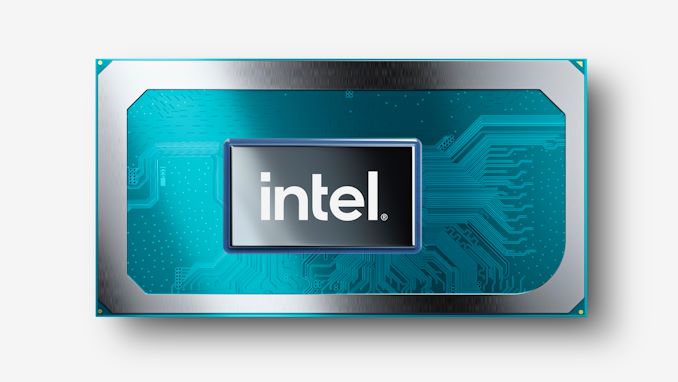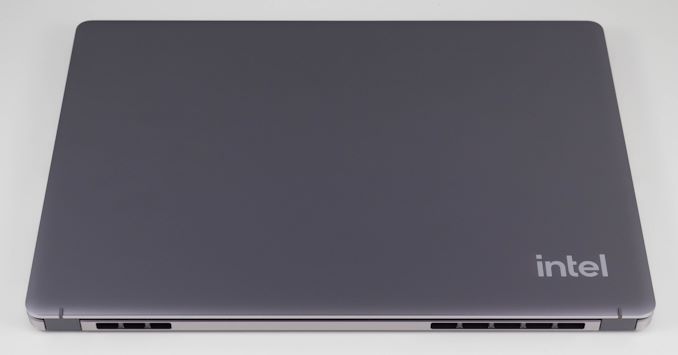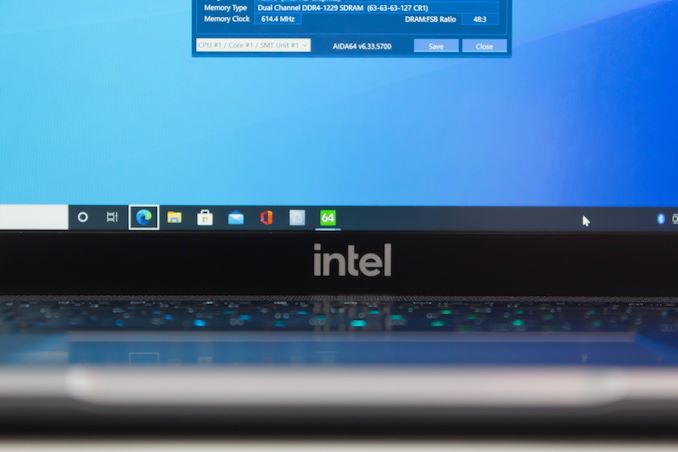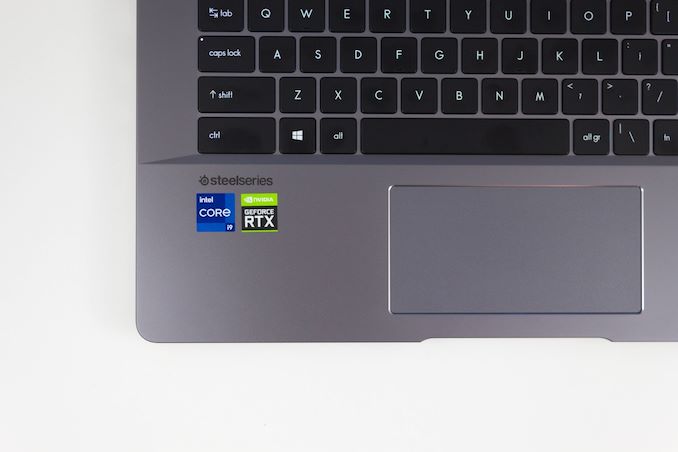Intel 11th Generation Core Tiger Lake-H Performance Review: Fast and Power Hungry
by Brett Howse & Andrei Frumusanu on May 17, 2021 9:00 AM EST- Posted in
- CPUs
- Intel
- 10nm
- Willow Cove
- SuperFin
- 11th Gen
- Tiger Lake-H

Last week Intel launched their Tiger Lake-H family of laptop processors. Aimed at the larger 14-inch and above laptops, this processor family is Intel’s newest offering for the high-performance laptop market, stepping in above Intel’s mobility-focused U and Y series of chips. Based on the same Tiger Lake architecture that we first became familiar with last year, Tiger Lake-H is bigger and better (at least where the CPU is concerned), offering up to 8 CPU cores and other benefits like additional PCIe lanes. Overall, Intel’s H-series chips have long served as the performance backbone of their laptop efforts, and with Tiger Lake-H they are looking to continue that tradition.
While last week was Tiger Lake-H’s official launch, as has become increasingly common for laptop launches, the embargoes for the launch information and for hardware reviews have landed on separate dates. So, while we were able to take about the platform last week, it’s only today that we’re able to share with you our data on TGL-H – and our evaluation on whether it lives up to Intel’s claims as well as how it stacks up to the competition.
Like Intel’s other laptop chips, Tiger Lake-H has multiple facets, with the company needing to balance CPU performance, GPU performance, and power consumption, all while ensuring it’s suitable to manufacture on Intel’s revised 10nm “SuperFin” process. Balancing all of these elements is a challenge in and of itself, never mind the fact that arch-rival AMD is looking to compete with their own Zen 3 architecture-based Ryzen 5000 Mobile (Cezanne) APUs.
| Intel Tiger Lake-H Consumer | ||||||||||
| AnandTech | Cores Threads |
35W Base |
45W Base |
65W Base |
2C Turbo |
4C Turbo |
nT Turbo |
L3 Cache |
Xe GPU |
Xe MHz |
| i9-11980HK | 8C/16T | - | 2.6 | 3.3 | 5.0* | 4.9 | 4.5 | 24 MB | 32 | 1450 |
| i9-11900H | 8C/16T | 2.1 | 2.5 | - | 4.9* | 4.8 | 4.4 | 24 MB | 32 | 1450 |
| i7-11800H | 8C/16T | 1.9 | 2.3 | - | 4.6 | 4.5 | 4.2 | 24 MB | 32 | 1450 |
| i5-11400H | 6C/12T | 2.2 | 2.7 | - | 4.5 | 4.3 | 4.1 | 12 MB | 16 | 1450 |
| i5-11260H | 6C/12T | 2.1 | 2.6 | - | 4.4 | 4.2 | 4.0 | 12 MB | 16 | 1400 |
| *Turbo Boost Max 3.0 | ||||||||||
Intel’s Reference Design Laptop: Core i9-11980HK Inside
For our Tiger Lake-H performance review, Intel has once again sent over one of their reference design laptops. As with the Tiger Lake-U launch last year, these reference design laptops are not retail laptops in and of themselves, but more of an advanced engineering sample designed to demonstrate the performance of the underlying hardware. In this specific case, the BIOS identifies that the laptop was assembled by MSI.
Wanting to put their best foot forward in terms of laptop performance, Intel’s TGL-H reference design laptop is, as you’d imagine, a rather high-end system. The 16-inch laptop is based around Intel’s best TGL-H part, the Core i9-11980HK, which offers 8 Willow Cove architecture CPU cores with SMT, for a total of 16 threads. This processor can turbo as high as 5.0GHz on its favored cores, a bit behind Intel’s previous-generation Comet Lake-H CPUs, but keeping clockspeeds close while making up the difference on IPC.
Unfortunately, their desire to put their best foot forward means that Intel has configured the CPU in this system to run at 65W, rather than the more typical 45W TDP of most high-end laptops. 65W is a valid mode for this chip, so strictly speaking Intel isn’t juicing the chip, but the bulk of the Tiger Lake-H lineup is intended to run at a more lap-friendly 45W. This gives the Intel system an innate advantage in terms of performance, since it has more TDP headroom to play with.
| Intel Reference Design: Tiger Lake-H | |
| CPU | Intel Core i9-11980HK 8 Cores, 16 Threads 2600 MHz Base (45W) 3300 MHz Base (65W) 5000 MHz Turbo 2C 4500 MHz Turbo nT |
| GPU | Integrated: Xe-LP Graphics 32 Execution Units, up to 1450 MHz Discrete: NVIDIA GeForce RTX 3060 Laptop 30 SMs, up to 1703MHz |
| DRAM | 32 GB DDR4-3200 CL22 |
| Storage | 2x OEM Phison E16 512GB SSD (NVMe PCIe 4.0 x4) |
| Display | 16-inch 2560x1600 |
| IO | 2x USB-C 2x USB-A |
| Wi-Fi | Intel AX210 Wi-Fi 6E + BT5.2 Adapter |
| Power Mode | 65 W (Mostly tested at 45W) |
Meanwhile the focus on CPU performance with TGL-H does come at a cost to integrated GPU performance. TGL-H parts include Intel’s Xe-LP GPU, but with only 32 EUs instead of the 96 found on high-end Tiger Lake-U systems. With TGL-H, Intel is expecting these systems to be bundled with discrete GPUs, so they don’t dedicate nearly as much die space to an integrated GPU that may not get used much anyhow. To that end, the reference system comes with an NVIDIA GeForce RTX 3060 Laptop graphics adapter as well, which is paired with its own 6GB of GDDR6.
Rounding out the package, the system comes with 32GB of DDR4-3200 installed. Storage is provided by a pair of Phison E16-based OEM drives, allowing Intel to show off the benefits of PCIe 4.0 connectivity for SSDs. Finally, Wi-Fi connectivity is also Intel-powered, using the company’s new AX210 adapter, which offers Wi-Fi 6E + BT5.2 on a single M.2 adapter. It’s worth noting that the AX210 is a fully discrete adapter, so it doesn’t leverage TGL-H’s integrated (CNVi) MAC, as that doesn’t support Wi-Fi 6E.
And, in keeping with making this reference system look as close to a retail design as reasonably possible, Intel even put the usual Intel Core and NVIDIA GeForce stickers on the laptop.
Unfortunately, we’ve had relatively little time with the system ahead of today’s embargo. The embargo on performance figures was originally scheduled for last Thursday (May 13th). However due to delays in shipping these laptops to reviewers, we didn’t receive the system until the end of last week, and Intel bumped back the embargo accordingly. So with just over two days to look over the system, we’ve really only had a chance to take a look at the most critical aspects of the system when it comes to performance.














229 Comments
View All Comments
schujj07 - Monday, May 17, 2021 - link
You are comparing a gaming laptop against a high end professional laptop. First the 4900HS is a 35W CPU and the 10810U is a 15W CPU. If both laptops have equally size batteries, the one with the lower TDP "should" have longer battery life. On top of the the G14 has a 120Hz display and a dGPU. Both of those will pull extra power and the screen was specifically talked about in reviews of the laptop. Setting the screen to a 60Hz refresh rate instead of 120Hz significantly increased battery life. Finally the weird freezes is most likely due to the dual GPU design and switching between the iGPU and dGPU. Unless you are using so much RAM that you are page swapping.Otritus - Wednesday, May 19, 2021 - link
@schujj07 I have the same zephyrus laptop as morello159. I haven't experienced weird freezes when switching between gpus on mine, or my old laptop with an intel processor and nvidia gpu, so optimus working isn't likely to be causing the freezing. The random high power draw is a valid complaint though. I think the randomness is caused by Asus's turbo settings, which was mostly fixed by me modifying power limits and disabling turbo. But, the default experience is the processor randomly boosting ridiculously high when it should be in a near idle state and not clocking anywhere near as high. Like the chip randomly pushes all 8 cores to 3.8Ghz, when it should be running in the 1.4-1.7Ghz range.bji - Monday, May 17, 2021 - link
Why should I care AT ALL that one platform has been more stable *for you* (your words)? You are irrelevant. Just one piece of anecdotal data.Calin - Tuesday, May 18, 2021 - link
They are trading blows in performance, but AMD is doing that on 35W instead of 45W for Intel.For manufacturers that use the same chassis with Intel AND AMD processors, the Intel one will run hotter, be noisier and/or have lower battery life when working hard (I don't seem to find anything related to idle/low power consumption).
jenesuispasbavard - Monday, May 17, 2021 - link
If you're planning on further testing, maybe using Intel XTU you can limit the PL1/PL2 to 45W and see how that performs?jenesuispasbavard - Monday, May 17, 2021 - link
Maybe I should scroll to page 2 before commenting on page 1...vyor - Monday, May 17, 2021 - link
I'm sorry, but your SPECFP2017 results are just wrong. There is no possible way that the 1185G7 is faster than the 11980HK by 2x in 503.bwavesThat's just absurd, especially when every other test bar 3 shows the exact opposite results, and even of those that show similar results it isn't nearly to the same degree baring 549.fotonik, and that one has the 4900HS somehow being faster than the 5980HS.
So no, your testing is just wrong and broken.
Otritus - Monday, May 17, 2021 - link
The 1185G7 being twice as fast is a little questionable, and possibly the results for the Tiger Lake processors were switched accidentally.As to the 4900HS being faster than the 5980HS in one very specific subtest, I suppose companies have never released a new CPU architecture slower than the old one. That's why Bulldozer was well received for its incredible performance over Thuban. Rocket Lake was well loved for consistently beating Comet Lake and Zen 3 in gaming, with the 11900K always at the top of the chart. Broadwell-S of course isn't better than Skylake or competitive with Coffee Lake in gaming.
vyor - Monday, May 17, 2021 - link
Except that Zen3 is consistently faster in almost every way.Otritus - Monday, May 17, 2021 - link
Keyword "almost"Zen 3 does not win every benchmark over Zen 2, just the vast majority of them due to superior clock speeds and IPC. In 1 very specific subtest, out of all the test conducted, is it really unreasonable to see the older architecture get a win. The last time I can think of a new architecture winning every single benchmark was Conroe. Sandybridge might also get this title with workloads that didn't need more than 4 cores, but I don't exactly recall. Remember IPC is an average of performance at a given frequency, so if a few benchmarks have negative improvements in IPC, but most have large positive improvements, you can easily see a 20% IPC uplift.